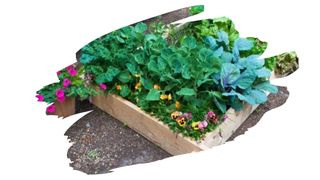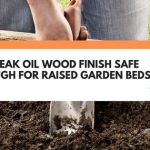Knowing exactly how pallet wood has been treated, (and what it has been treated with), is important. Especially if you want to keep your garden soil free of toxic chemicals.
So, in this post, we reveal how heat treated wooden pallets are made — and how to identify them.
You’ll also learn why even ‘safe’ heat treated wooden pallets can sometimes still contain toxic chemicals, such as arsenic. And keep reading to find out the best way to weatherproof wooden pallets.

This post may contain affiliate links to products that we receive a commission for (at no additional cost to you). Learn more here.
Is Pallet Wood Safe For A Garden? Or Are Wood Pallets Too Toxic?
It mostly depends on how that wooden pallet has been treated — and what it’s been treated with.
You see, wood can have bugs, termites and insects in it, after it’s been milled. So, to get rid of those pests, lumber needs to go through a treatment process.
OK…But What Does The Treatment Of Wood Have To Do With Pallet Toxicity?
Well, years ago, wooden pallets were put through a fumigation treatment in order to get rid of those bugs. And the substance used to disinfect those pallets was a toxic chemical called Methyl Bromide.
Now, Methyl Bromide is some very nasty stuff. If you inhale it, ingest it, or any of it gets on your skin, it can cause serious health issues.
Which is why wooden pallets that have been marked as ‘MB’ (Methyl Bromide) are much too toxic to use in your garden. Particularly as the last thing anyone needs is Methyl Bromide-treated wood near their vegetable garden!
However recently, the way wooden pallets have been treated has changed. And that change has made pallet wood much safer.
Related Post: Railroad Ties Vs Pressure Treated Fence Posts: Which One’s Best For Your Garden?
So Which Pallets Are Safe To Use For Gardening?
In the US, Canada and UK, pallets are more likely to be treated with heat, rather than Methyl Bromide.
These high-heated pallets are referred to as ‘heat-treated’ pallets. And they are heated to temperatures so hot, that it removes all insects that may be nestled in them.
And Are Heated Treated Pallets Safe For Gardening?
Yes they are. You see, there are three main types of heat-treated wooden pallets:
Heat Treated Pallets (Marked as ‘HT’)
These pallets are treated by placing them in a chamber, and baking them at temperatures of around 56°C (132.8°F) for over half an hour.
There are no fumigation chemicals involved here, which is why heat-treated pallets are safe — certainly much safer than any pallets disinfected with Methyl Bromide.
Kiln Dried Pallets (Marked as ‘KD’)
Kiln Dried Pallets get put through pretty much the same process as HT pallets. Except, they are super heated in a kiln oven, instead of a chamber.
Another key difference is the temperature they’re heated up to (and for how long).
Kiln Dried Pallets get heated to a sweltering 94°C (201.2°F) for up to 36 hours. Which is certainly more than hot enough to get rid of any pests still hanging around.
So, just like with HT pallets, KD pallets are safe to use.
Debarked Pallets (Marked as ‘DB’)
Last, but not least, are Debarked Pallets. These pallets get put through the same heat-treatment process as HT pallets.
Except Debarked pallets will have had their tree bark removed before they get put through the heating process. The reason for removing the bark is simple; it makes it easier to heat up and dry out that timber.
And, once again, similarly to HT and KD pallets, debarked pallets are also safe for you to use.
So That Means I Can Use Any Pallet Marked HT, KD, or DB?
Almost, but not quite.
While heat and fumigation do a great job at getting rid of insects, they do nothing to help stave off rot. So, if that pallet becomes damp with rainwater or humidity, wood rot can take hold. And sometimes bugs can even make a comeback as well.
Which is why wooden pallets often get put through a secondary treatment process, called pressure treatment.
Related Post: Is Wood Stain Really Safe For My Vegetable Garden? (What You Need To Know)
And What Is ‘Pressure Treatment’?
Pressure treatments involve infusing wood with rot-resistant chemicals. The job of those chemicals is to act like a fungicide, and fight off wood rot bacteria.
However, those self-same wood preserving chemicals are made of some pretty toxic stuff too. For example, some pressure treatment wood preservatives — such as Chromated copper arsenate (CCA) — can even contain arsenic.
Now, on one hand, these wood preservatives are the only thing preventing wood from rotting away — especially if that timber has prolonged ground contact.
But, on the other hand, those wood preserving chemicals can leach into your garden soil. Which is very worrying if you use that pallet near a patch of soil meant for growing food.
How Do You Check If Pallet Wood Has Been Pressure Treated?
Pallet wood, that has been put through a pressure treatment, will have a stamp clearly indicating it’s treatment.
The two main stamps for pressure treated pallets, (from the US, UK, and Canada), are GC (Ground Contact) or PT (Pressure Treated).
So, if you’re using reclaimed heat treated pallet wood, make sure you check it carefully for those GC/PT stamps.
Related Post: Should You Use Cinder Blocks (Vs Wood) For Your Raised Bed?
And What Can You Do Prevent Wooden Pallets From Rotting (If They Haven’t Been Pressure Treated)?
The best way to protect any outdoor wooden structure, is to thoroughly coat it with an exterior wood sealer.
But, when it comes to your garden, you’ll need to make sure you are using a non-toxic sealer product. Which is why Seal It Garden Wood Sealer is the best way to protect those wooden pallets.
This non-toxic wood sealer is eco-friendly, since it does not contain harmful chemicals, solvents, metals or sulphates.
What’s more, it has been specially formulated to really bind onto the fibers of that pallet wood. This way, there’s next to no chance of this sealer sliding off and leaching into your garden soil.
You can learn more (and find the latest prices for) this plant-safe wood sealer over on Amazon.
To Wrap Up, Here Are The 3 Key Takeaways From This Post…
- 1). Heat treated pallets marked as HT, KD or DB, are safe to use in a garden.
- 2). However, avoid heat treated pallets that are also marked as GC or PT. Those pallets will have likely been infused with chemical preservatives that are too toxic to have in your garden.
- 3). Also, if you want your wooden pallets to last, coat them in a non-toxic wood sealer. An exterior wood sealer product will help weatherproof pallet wood.
References:
Overview of Wood Preservative Chemicals | U.S. Environmental Protection Agency (US EPA)
Methyl Bromide | U.S. Environmental Protection Agency (US EPA)



